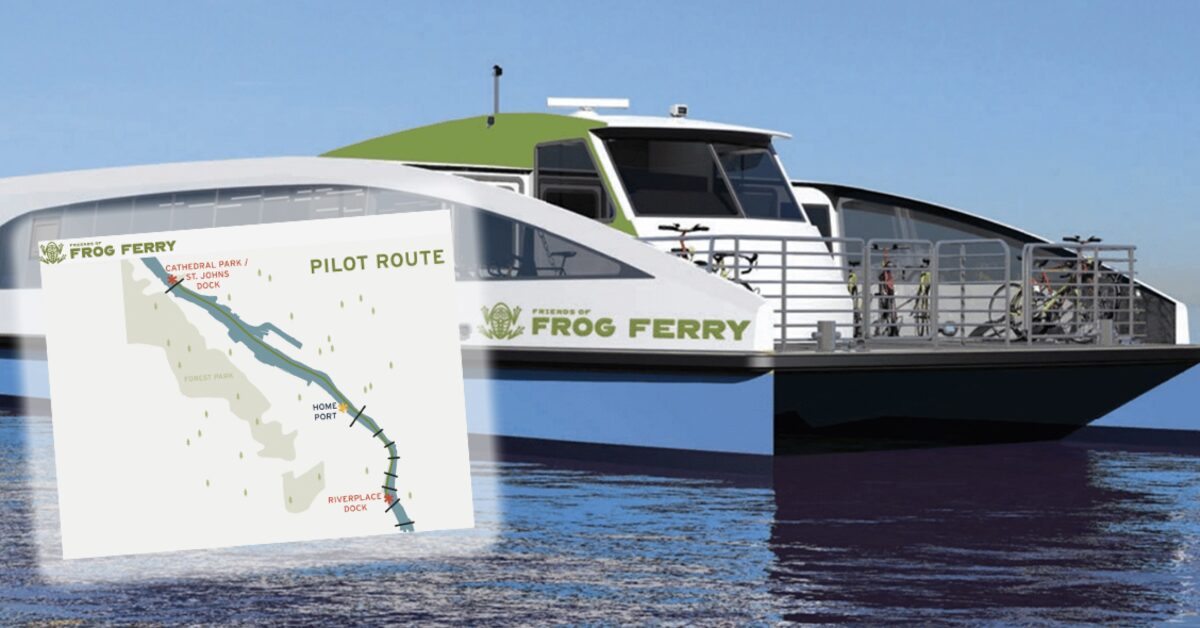
“We are all ready for a new and better Portland.”
— Susan Bladholm, Frog Ferry
At a press conference on Tuesday, the nonprofit Friends of Frog Ferry detailed plans for a pilot project that will launch next summer. Once the vessel hits the water, about 70 people at a time will be able to ride from Cathedral Park to RiverPlace in 25 minutes — about half the time the 9.5 mile distance would take to travel by bicycle and just a few minutes slower than driving (without traffic).
We’ve tracked this ambitious attempt to establish a Willamette River commuter ferry since it first gained steam in 2018. Positive results from a feasibility report released by Friends of Frog Ferry last fall gave the group momentum to seek funding and key partnerships for the pilot project.
One of those partnerships is with the City of Portland. At Tuesday’s press conference a name familiar with local transportation innovation, former PBOT Commissioner and Mayor Sam Adams, voiced Portland’s official support for the project. As director of strategic innovations for Mayor Ted Wheeler, Adams said the City of Portland will sponsor Friends of Frog Ferry’s $3.3 million federal grant application.
Advertisement
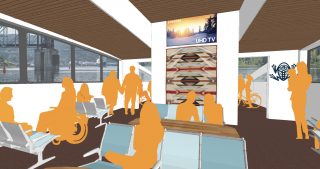
With Portland and the State of Oregon on their side (ODOT has awarded $500,000 toward the pilot project) and with necessary planning processes in the rear-view mirror, the pilot project is all queued up for federal funding. Once the expected funds come through, Friends of Frog Ferry says they’ll run one, 70-passenger vessel 14 hours a day Monday through Friday from St. Johns to RiverPlace. Saturday service is also on the table. According to the group’s estimates, 1,000 people will use the ferry per day and 600 of them would have previously driven cars for the same trips.
As you can see in the images, bikes will be allowed on the ferry. Tickets will cost $3 each way ($2 for honored citizens). The vessel that will be used in the pilot project will run on R99, a renewable diesel fuel. Ultimately the system is expected to use an all-electric fleet.
“A passenger ferry service will help address equitable transit for all Portlanders and better connect residents with the outdoors and our river system,” said Friends of Frog Ferry Founder Susan Bladholm in a statement. “We are all ready for a new and better Portland, one that prioritizes social and climate equity and the future for our city. Frog Ferry is part of that vision, and we are confident in our city and downtown as the pandemic eases and residents begin returning downtown.”
The pilot project is planned to run for two years (2022 – 2024) at a cost of $9.4 million. After 2024, the plan is to add more vessels and stops. Capital costs to stand up the full system are estimated to be $40 million and the service would cost about $7 million per year to operate.
— Jonathan Maus: (503) 706-8804, @jonathan_maus on Twitter and jonathan@bikeportland.org
— Get our headlines delivered to your inbox.
— Support this independent community media outlet with a one-time contribution or monthly subscription.


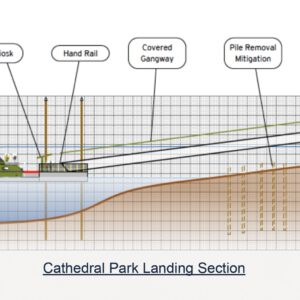

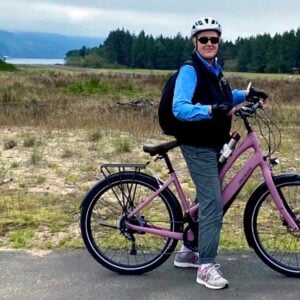
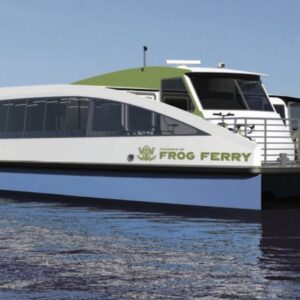
Thanks for reading.
BikePortland has served this community with independent community journalism since 2005. We rely on subscriptions from readers like you to survive. Your financial support is vital in keeping this valuable resource alive and well.
Please subscribe today to strengthen and expand our work.
Not sure how this investment is an improvement over, say, improving bus service between St. Johns and downtown, but new shiny things FTW.
I see a lot of advantages to ferry over the bus:
– No traffic on the river = much more reliable times and pick-ups/stops.
– much less environmental/social/livability impact (Buses are loud, polluting, they endanger other road users, they have lots of wear-and-tear on pavement, and so on).
– Some people who won’t ditch their car for the bus, will ditch their car for a ferry ride (this expands the no-car/low-car lifestyle product selection)
Also worth noting that transportation funding is not always zero sum. There is federal funding for ferry systems… And you can’t get that funding unless you have a ferry system! It cannot be spent on bus service.
Plus, sometimes the bridges and streets are closed due to various things like a waterline breaking, emergencies, and other things. A ferry would likely not be blocked until another flood takes place with gobs of debris floating in the river.
Or trains. The fastest bus route between St Johns and downtown is the 16, which frequently gets delayed at the railroad crossing where Naito goes by the Steel Bridge. Sometimes the railroad just parks trains across that intersection for extended periods of time.
A boat will be much more subject to weather issues. On a per passenger basis I bet pollution and fuel consumption will be greater than a bus. Doesn’t make economic sense either.
interesting. Hadn’t thought of weather, but I doubt we’d have many days that would keep one of these ferries out of the water. Don’t they run very reliably in other major west coast cities?
Weather/current/debris all could impact the ferry…it impacts Portland Spirit, which is a much larger vessel. Passenger-only ferries in Puget Sound and the Bay Area are also larger than proposed here. They are choosing a small one to avoid bridge lifts, especially the lower deck of the Steel. There is marine traffic (primarily grain ships) in that stretch of the river, and one grain ship turning could throw the schedule off for a run or two.
Hi Jonathan – I respect the enthusiasm for new modes, but I have to disagree with you on this one. As a rider, I love ferries – it was my favorite way to commute home when I lived in NYC – but with the exception of some high volume lines (WA state ferries, Staten Island Ferry) the numbers just don’t pencil out. I think this proposal is most akin to the NYC Ferry system, which mostly operates along the East River. The Citizens Budget Commission skewered it in 2019 over its high operating costs and attendant subsidies. If it requires a $10.73 subsidy per ride in dense NYC, imagine what it would require here – and then consider how that compares to the cost of providing bus service (even the low-ridership line 16 had a total cost per ride of $7.48 pre-COVID. I don’t see Frog Ferry absorbing those costs without a substantial public subsidy.
Add to that the fact that most employers and residences sit fairly far back from the river and therefore aren’t well served by a ferry, and it doesn’t make a lot of sense. Certainly not when we could serve more people with improvements to bus service, including simply adding frequencies.
Hi TB,
Thanks for sharing these points. I think this thing merits a look. I’m not on the board or anything and I have no horse in this race. I’m just happy to see a ferry service actually get tried and tested. If it doesn’t work, we can have that debate when we are talking real money and real public subsidy and/or other costs.
My take on what’s going on here is they are taking the subsidy money to line their pockets. They kick it back to the fabricators, suppliers, etc. There’s no actual hope of or plan to sustain success. I’ve seen it in numerous industries with stimulus funds to spend. That’s why they started without investing in an electric drivetrain.
Yep, think how frequent or how much more off-peak service could be added on Lines 16 and 44 for this amount of money. This only really benefits you if you live within walking distance of Cathedral Park (and the vast majority of people in St Johns don’t). So that’s at least one additional transfer.
If you don’t work within walking distance of the river, then add another transfer as well.
The 44 takes almost an hour to get downtown from St. Johns during rush hour and you’re sitting in traffic (and creating it!) the whole time. Additionally there is only room for 2 bikes on each bus. The 16 only stops near Cathedral Park. As a resident of St John’s I can tell you that I would much rather transfer to Cathedral Park (or bike there) in order to ride a boat down our beautiful river than do the same to ride a bus down 30.
This explanation by Emily above is why I support this endeavor now. The people who live in St. Johns can see the usefulness and how it will improve their commute. That’s enough for me.
And no we don’t have to have the numbers “add up” all the time. We know St. John’s has been underinvested in for a long time. The time savings and enjoyability of the route counts for a lot, for people use to battling Vancouver peak commuters everyday. This will be an improvement.
The planners in this big project have shifted their ferry ports significantly to address real traffic bottlenecks and providing a real alternative shift. This is what good community planning looks like. Thank you Frog Ferry for changing your ferry ports. They may get one down to Lake Oswego, but not until there is enough ridership to merit the expansion. Equity first. Prove it first in areas that have been historically underserved. St.Johns and Riverplace have enough density to support that level of ridership for a test run.
IDK if anybody else was watching the Willamette Lockes authority has been treating their Indigenous partners pretty badly. They walked out and now its going no where. So there’s that…..
I have rethought about Riverplace. I think that station be moved and should have priority over the Teddy Bear Tourist Cruise next to Salmon Street. VERY VERY important to have downtown walkability from the ferry station. Riverplace is outside of the walk catchment. Details matter. Also Stations are the most expensive. If we pay for the stations to get installed, then any new connecting service (ie: a high priced fancy private speed shuttle from Lake Oswego), should be forced to pay additional docking and transfer fees.
There has been some talk about running a timed-transfer shuttle loop service from Lombard St in St Johns down to Cathedral Park and back again. A Frog Ferry shuttle, not TriMet. Not sure what the status of that is, but it seems pretty important. Would also be good to have Biketown expand to that area.
At a SJNA meeting a couple months ago, the FF rep indicated they see the need and would like to see such a shuttle, but they have no interest in standing it up or operating it themselves. I think in their mind SJ would somehow do it (e.g. the business association) but I see little chance of that happening. So there won’t be one.
“A passenger ferry service will help address equitable transit for all Portlanders and better connect residents with the outdoors and our river system,”
I’m all about the concept, but I’ll probably not use the system so it’s not for all Portlanders. It will be a fun weekend excursion, but not worth the investment. Better to see something like this from the ‘Couve to downtown Portland and give the Washington riders a break from the tolling if they utilize the service.
The eventual goal of the ferry will include service from Vancouver to downtown Portland. This stage is just the proof of concept. It will also include service from Oregon City.
I really must be missing how this is going to be a viable venture. I am super stoked on the prospect of riding this ferry, but I just don’t see how this pencils out. With each trip taking 25 minutes, it would be generous to do two trips each hour. With 14 hours of service, we’ll call it 28 trips. At nearly full capacity for 252 days per year (no weekends as yet), over 2 years, we’re looking at around $2.6 million in revenue against a $9.4 million operating budget. Please someone tell me how this makes sense – I’d love to see this work!
They plan to have 7 vessels once the system is up and running (and not just a single boat pilot). This image might help. It’s from their “Pilot Project Cost Overview”
That document also shows that one-way fares are planned to be at least $5 after the pilot project, compared to a $5 all-day transit pass. It’s an indication that fares would have to be higher to avoid needing a massive public subsidy, which is assuming a certain level of ridership that is nowhere near guaranteed.
Thanks Jonathan, for the graphic. I do recognize that the post-pilot scaling is there, I was really pointing out the 2022-24 period with one boat, and how much shortfall there is between ticket prices and operating budget. I suppose if I saw that difference with Trimet or C-Tran comparisons, I could understand having a such a shortfall. Again, thank you.
I think the Trimet data is actually comparable to what’s being talked about with the ferry. Pre-covid a bus ride was $2.50 and the cost to operate was $6. The majority of the cost per ride was coming from non-ticket sales. The Ferry shows tickets and ‘onboard sales’ covering more like 60% of the cost of a ride. These financials are better than I thought they would look.
https://trimet.org/about/dashboard/index.htm
If we’re viewing this as a transit service and not a business, then the revenue shouldn’t matter.
I do want to view it as a transit service, but I think revenue does matter when it’s funding less than 33% of the operating budget.
Unfortunately the reality is that most transit services have a farebox recovery rate that is that low.
Most farebox recoveries of transit service are only around 25-30% in car dependent places. i.e. most of the US. This is in line with that. So your point is taken on the frequency being a problem, and I would push for this to be more frequent than every half hour.
That’s how transit service works. Fares never cover the full cost, the rest is subsidized through taxation. TriMet fare is $2.50 but it only covers like 30% of the cost. Some even argue that transit should be free at point of sale and fully subsidized, like schools or libraries! Imagine that!
I wonder if they could run a weekend extension to Swan Island for the recreational riding opportunities.
Im guessing you mean Sauvie, but yes I agree!
Will you be able to pay with a hop card? With a name like Frog Ferry, I sure hope so.
not integrating into the existing system seems like a huge fail. Great comment!
It’s bad that you can’t use Hop on the tram (when it’s taking the general public). Not being ticket-based means that services with different price points are not a problem.
I think the rapid and firm support of this project by city and state has more to do with tourism than actual transportation utility.
PS: Given the minuscule quantities of R99 “biodiesel” available, the main effect of using R99 is to cause someone else to burn more fossil juice (e.g. rearranging deck chairs on our sinking ship).
Yes. But at least they plan on switching to electric motors when/if they scale up (which might just displace current electricity consumers from renewable sources to fossil fuels, but it could also spur more growth in renewable generation).
I read the article to say that the biodiesel is in the test phase and that they intend to operate as an electric fleet. A ferry may prove easier to electrify than the comparable bus route.
That logic would apply to anyone using R99. So then … what?
It’s funny when people compare times to bike places. There are plenty of people who can bike from Cathedral Park to River Place in 25 minutes, myself included. So to say it’s half the time it is to bike really depends on the individual. There would be such wide variation.
25 minutes? You’d have to average over 20 MPH over the entire route without any stops. It’s doable, but that’s in the 90th percentile range for recreational, non-competitive racing cyclists (based on my purely anecdotal knowledge of the kind of shape that I was in when I could consistently average 20 MPH over any kind of distance).
And if you’re achieving those speeds over that distance during peak commute times while biking through parts of the Central City, you’re almost certainly blowing through some red lights, making some aggressive passes, and breaking traffic laws along the way. Or at least, that’s what you would have been doing to achieve those speeds in normal workday bike and motor vehicle traffic pre-covid.
Now, doing that time on an ebike, with top speeds well into the 20s or even 30s, no problem. But that speed is borderline elite for a typical cyclist on a typical commuter bike.
I used to make it in 35 or so. There isn’t a ton of stop and go. Williamette is a good uninterrupted stretch, then through Overlook and drop onto Greeley (fast downhill) to the Broadway Bridge. The bridge also dumps you into a downhill.
Getting home was slower, because I only rode up Interstate if I got off early enough to make last call at the Nite Hawk:)
That’s incredibly fast and atypical. I live in Overlook and it takes me exactly 25 minutes to get to the middle of downtown, and I’m a pretty fast rider.
Yes there is a lot of variation. My point EXACTLY; saying it is half the time is odd when there is so much range. Yes some people are fitter than others, but few would take 50 minutes. Anyways, there are virtually no stops going over the bridge and coming in via 30 to Naito and that route is just 8.5 miles.
This is actively going to harm active transportation, and recreation on the waterfront, in Portland by making the Steel Bridge lower deck (a vital link in the active transportation network) raise a ridiculous number of times per day. Cancel this boondoggle and redirect the money toward better bus service, or better yet an actual BRT line from St. John’s to downtown.
Aren’t they designing the ferry to fit under the lower deck at normal water levels?
I agree that BRT would be a better idea than a ferry. But you would have to increase the startup cost 10,000% to build a 9 mile BRT line from St Johns to downtown.
You wouldn’t need a downtown BRT line. We already have the yellow line, which is inaccessible from St. Johns. The distance between downtown St. Johns and the N Lombard TC is only 3.7 miles and makes huge amounts of sense because it would connect St. Johns (21,000 people), University Park, and Portsmouth to the MAX system. TriMet would never go for it because they only like building high-cost fixed rail systems through low density neighborhoods.
For that, you wouldn’t even need to do BRT . Just an enhanced, regular bus line, like they are doing on Division (with a regular bus, not an articulated bus). Just one bus that shoots down Lombard from the center of St Johns to the Lombard TC and then loop back around, with a handful of stops along the way. Well more than one bus. You’d probably want three or four making the loop to keep the service frequent.
But the 16 would still be a much better option on the way into downtown from St Johns if they would increase the frequency. It takes a little longer to get downtown from St Johns than the yellow line does from the Lombard TC. But if you add in a bus connection from St Johns to get to the Lombard TC, it would still probably take longer on the yellow line, unless there was a train blocking Naito at the Steel Bridge, which there often is.
On the way back from downtown, with the daily massive backups on Bridge Ave, it would probably be a crapshoot as to which option would be faster, a frequent service 16 bus or a yellow line trip with a fast, frequent bus connection.
They’re using a very short boat that will not require Steel Bridge lifts.
Ok good. I still don’t support the project. The reason the ferries are successful and make sense in Seattle is that it’s a long way to the other side of the Sound by driving, transiting, riding, or walking; the ferry cuts off a significant distance and is much less expensive than a new bridge across the sound. Same with the ferries farther south in the Willamette Valley used to cross the river. That is emphatically not true here, where one can in almost the same distance that a ferry would take get to their destinations using roads or paths.
Yes, and that’s only in the cases of the several destinations that are connected by roads. Many Washington State Ferry routes connect to islands you can’t get to except by boat or plane.
I swam once from Seattle to Bainbridge Island, but wouldn’t recommend that for commuting.
The biggest problem with ferries is that usually there is very little in terms of destinations within walking distance of ferry terminals. this is partially because half of the area in walking distance is almost always water, and also because most cities are built most densely around a road or railroad intersection, not near the water.
For an example of this it’s pretty easy to just look at Cathedral park– the Cathedral Park ferry stop would be in easy walking distance of only a handful of homes and businesses, and it’s at the bottom of a pretty big hill. Even if the ride on the ferry were a lot faster than taking the bus or biking, there are not many trips where it would be the best option.
Hundreds of units have been built in Cathedral Park in recent years, and there are hundreds of affordable housing units coming to the area in the near future. It’s a very fast-growing area.
30,000 people live in St. Johns, fewer than live in Redmond, Bend’s small sibling. And even fewer live within a short walk of the Cathedral Park water front and work near RiverPlace. This ship is gonna sink.
St. Johns is a huge neighborhood and Cathedral Park is on the very extreme west edge of it. I can’t see this succeeding as the neighborhood currently stands, but I can see the Frog Ferry boosting land value near the park, which would be good a thing because the area around Cathedral Park is terribly under-developed. I can imagine new apartments going up advertising the ~20 minute boat ride to downtown.
The times they chose for arrivals and departures are really odd. They are obviously targeting 8-5 workers, but for some reason the ferry leaves on the hour, so if you get off work at 4, you have to wait until the five o clock ferry and if you get off work at 5, you have to wait until the six o clock ferry. It also seems expensive. $120 a month if you work 20 days a month. How much does a monthly parking pass cost down there?
I’m also curious how they are going to deal with parking. Most of the ferry riders will be driving to catch the ferry and the neighborhood is not going to be super happy about it.
The equity angle is also suspect to me. I can’t imagine this route being really viable for anyone outside of office workers/ 8-5 workers.
OMG – I’ve joked about wanting to start a ferry service just like this for years. A colder version of the Bangkok water taxis, but so good for those couple months in the summer.
Complete waste of money. Why don’t they allocate those funds to take on a bigger issue, like traffic congestion? The fact that the interstate bridge is a complete disaster. Homeless issues could utilize these funds as well.
As hard as you try people are not going to give up their vehicles and start riding bikes. So, maybe use our heads and fix problems that are far more detrimental to the city.
SMH at the ignorance. We have a majority of our bridges in the danger zone for ratings, yet we spend money and build a new walking, biking bridge? No wonder they have news stories called “Is Portland over?”
I don’t get how this works. It provides express service from Cathedral Park to Riverplace dock. From there you can walk three blocks to catch one of the streetcars, for a slow, circuitous ride to destinations downtown. There are no practical transit connections at the north end that don’t involve walking half a mile up a steep hill. It’s “a few minutes slower than driving” without traffic as long as you don’t count walking time at each end. It’s probably faster than a local bus (assuming you want to make that specific trip), but slower than a non-stop express bus from N. Lombard & Burlington to the OHSU Schnitzer campus.
Why would anyone use this service, beyond a novelty ride? It seems to serve no useful transit purpose.
This hydro-monorail is absolutely the wave of the future. The village of St. Johns needs all the street car connectivity it can get in the next hundred years. I like the idea of a Swan Island and Sauvies Island docks. Oregon City is River City! The area in the rendering where the Bicycles are shown will actually be where smokers hang out, exhale, and flick butts into the water.What!? It’s just bio-degradable paper,don’t tread on their freedoms, man.
“…people…will be able to ride from Cathedral Park to RiverPlace in 25 minutes — about half the time the 9.5 mile distance would take to travel by bicycle and just a few minutes slower than driving (without traffic).”
This is a faulty, misleading way to look at trip times. Sure, if the timer starts ticking when the boat leaves the dock and stops when it gets to the destination dock, it’s 25 minutes. But you have to add several minutes waiting to start, plus whatever time it takes to get to the ferry, plus time from leaving the ferry to walk or ride to your destination. The typical door-to-door time may be closer to an hour or so.
Biking the whole way, there’s no wait time. For many people, buses will pick you up closer to your home and drop you off much closer to your downtown destination than RiverPlace. Driving, there’s no wait at the start of your trip, and you’re likely to be able to park much closer to your destination than RiverPlace.
Each person’s door-to-door times will be different of course. My guess is the ferry, for most people, is not going to look nearly as good compared to other modes when timed door-to-door rather than dock-to-dock.
To everyone nitpicking about how it’s not perfect and there are flaws, keep in mind one proverb. “Perfect is the enemy of good.” If you don’t start somewhere, you won’t get anywhere. Build it and they will come. Buses are often stuck in traffic for hours, so until PBOT gets around to making more bus-only lanes, this is your best bet for rush hour traffic. To those complaining that nowhere important is near the waterfront, the same can be said for some MAX stops; those stops are still used by hundreds and hundreds of people a day.
I lived in St. John’s for many years, and bike commuted to Downtown and then bike/bused to Tualatin.
I’m pretty sure logistics would mean I would have never used this ferry to get to work. I’m not sure this will really benefit the residents of St. John’s, but it may be a cool way to boost tourism to the area. At least during the summer.
Totally love this. There are many reasonable concerns in this thread about the efficacy of this compared to other transportation options, but I think that just as a way for Portlanders to connect with our river at a very low cost (a few dollars, compared to owning or renting a boat) is well worth the effort.
This is modeled on the NYC ferry system, which I’ve used and does have some utility. At least it’s a similar-looking boat. The question is whether this would scale down to a Portland-sized city and is the investment worth it? The NYC ferry system is rather extensive with a regular schedule. I’m not really sure Portland could support a similar system.
https://www.ferry.nyc/